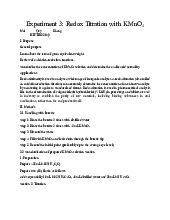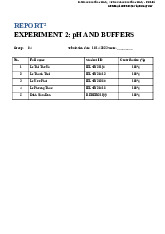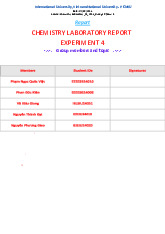






Preview text:
International University, Vietnam National University - HCMC 1 CHEMISTRY LABORATORY REPORT
EXPERIMENT 1: CHEMICAL REACTIONS
Group: ______________ Section: _____1_________ Date: ____________ Group members: Seq. Full name Student ID % contribution Signature Score (total = 100%) 1 2 3 4 5
Mßi thành viên s¿ ph¿i tÿ @ánh giá ph¿n công vißc @ã thÿc hißn, ghi % @ã thÿc hißn và kí tên. Total score: _______/100
International University, Vietnam National University - HCMC 2 CHEMISTRY LABORATORY I. Introduction
(Introduce what experiments you do in this report)
Trình bày rõ các nßi dung, các dÿng cÿ thí nghißm, summary l¿i nhÿng ki¿n thÿc Nã hßc
trong lab này s¿ N±ÿc full Nißm
II. Materials and Methods
(Describe what experiments you did in this report, write down each step of your experiments)
Nêu rõ các dÿng cÿ và hóa ch¿t Nß làm thí nghißm cing nh± các b±ßc chu¿n bß cÿa các thí nghißm Nã hßc.
III. Results and discussion
1. Reactions of Cu2+ Reaction Observation Chemical Equation 0.5M CuSO4
Hình ¿nh @ã chÿp @±a vào ô
Ph±¡ng trình ph¿n ÿng ph¿i ghi rõ hß sß cân + 2M NaOH này b¿ng 0.5M CuSO4 + 2M NH4OH Discussion:
Nói rõ h¡n vß các hißn t±ÿng @ã x¿y ra, t¿i sao l¿i có các hißn t±ÿng. Trong tr±ßng hÿp các thí nghißm
không ra k¿t qu¿ gi¿i thích thêm lí do t¿i sao không thß hoàn thành thí nghißm.
TI¾P TþC CÁC B¯ÞC NH¯ TRÊN VÞI CÁC THÍ NGHIÞM CÒN L¾I
International University, Vietnam National University - HCMC 3 CHEMISTRY LABORATORY 7. Flame test Solution Dominant flame Wavelength Frequency Photon energy (J) color (nm) (s- 1) Ghi rõ màu Quan sát màu Tính t¿n sß Tính ning l±ÿng LiCl ghi nh¿n b±ßc quang phß sóng NaCl KCl CaCl2 BaCl2 Discussion: IV. Conclusions
(conclude all your performance in this report)
Tßng hÿp l¿i các thí nghißm, các khó khin khi làm thí nghißm và cách kh¿c phÿc cÿa các b¿n.
|IÞM CAO NH¾T CHO 1 BÀI REPORT LÀ 100 |IÞM, CÁC B¾N HÃY CÞ G¾NG
TRÌNH BÀY TH¾T |¾P M¾T, HÌNH TH¾T RÕ |Þ |¯þC |IÞM TÞI |A NHÉ. VÀ
L¯U Ý CÁC B¾N PH¾I THþC HIÞN REPORT THEO FORMAT NÀY. REPORT
CÁC B¾N IN MÀU VÀ NÞP L¾I CHUNG CÙNG VÞI DATA SHEET VÀO |¾U MÞI BUÞI HÞC.
BEST WISHES FROM YOUR TA <3
International University, Vietnam National University - HCMC 4 CHEMISTRY LABORATORY REPORT
EXPERIMENT 1: CHEMICAL REACTIONS Group: 01 Section: 01
Date: September 17, 2020 Group members: % contribution Seq. Full name Student ID Signature Score (total = 100%) 1 2 3 4 5
Total score: _______/100
International University, Vietnam National University - HCMC 5 CHEMISTRY LABORATORY I. Introduction
Chemical reactions are the processes by which one group of chemical components are changed
chemically into another. Chemical reactions take place; reactants, the substances that are initially
involved in a reaction, are changed into products, which are often substances with distinct properties
and appearances. To determine whether the chemical reactions have occurred, we will conduct and
observe many types of phenomena in this experiment. A change in color, the formation of a solid, the
release of gas, the generation of heat, and the production of light and heat are all examples of visible
indications of chemical processes. We will also learn how to categorize chemical reactions. Synthesis,
breakdown, single displacement, double displacement, and combustion are the main types of reactions. Objective:
- To perform different types of chemical reactions (acid-base, precipitation, gas forming,
complex compound forming an oxidation-reduction reaction)
- To identify some of the products in these reactions and describe the chemical changes.
- To write and balance the chemical equations for the reactions observed. II. Materials and Methods
* Chemicals and Equipment: Equipment One 250 mL beakers &&&. Chemicals 0.5M CaCl2 0.5M BaCl2 1M NaOH &&&& * Procedure:
1. Reactions of Cu2+:
- First put 10 drops of 0.5M CuSO4 into each of three test tubes.
- Then add 10 drops of 2M NaOH into the first test tube; 2M NH4OH into the second test tube. &&& 7. Flame test:
- At first we lit the Bunsen burner.
- Secondly, we dip a looped wire into one of the solutions supplied, and then hold it in the Bunsen burner flame.
- After being saw the change in the dominant flame color, we recorded. - By using the wavelengths.
International University, Vietnam National University - HCMC 6 CHEMISTRY LABORATORY
III. Results and discussion
1. Reactions of Cu2+ Reaction Observation Chemical Equation 0.5M CuSO4 The formation of deep blue precipitate + 2M NaOH
CuSO4 + 2NaOH ³ Cu(OH)2 ³ + Na2SO4 (1)
Figure 1. The reaction between 0.5M CuSO4 and 2M NaOH 0.5M CuSO4 The formation of milky blue precipitate + 2M NH4OH
CuSO4 + 2NH4OH ³ (NH4)2SO4 + Cu(OH)2 (2)
Cu(OH)2 ³ + 2NH4OH ³ [Cu(NH3)4]SO4 + 4H2O (3)
Figure 2. The reaction between 0.5M CuSO4 and 2M NH4OH Discussion:
1) The reaction between CuSO4 and NaOH created Cu(OH)2 as demonstrable in chemical
equation (1). Cu(OH)2 is an azure precipitate which is shown in figure
1 and this type of reaction is a
double replacement/ precipitate reaction.
International University, Vietnam National University - HCMC 7 CHEMISTRY LABORATORY
2) The reaction between CuSO4 and NH4OH is a double displacement reaction and it is
supposed to create a pale blue precipitate. When an excess amount of NH4OH is added, the
precipitation is dissolved and gives a deep blue solution. Due to an error in the procedure, milky blue
precipitation is obtained instead.
TI¾P TþC CÁC B¯ÞC NH¯ TRÊN VÞI CÁC THÍ NGHIÞM CÒN L¾I IV. Conclusions
This experiment gives us the chance to carry out a variety of reactions, including synthesis,
breakdown, single displacement, double displacement, combustion, acid-base, complex compound
formation, and oxidation-reduction. After carrying out the aforementioned experiments, we are able to
distinguish between several phenomena, including color changes, precipitation formation, and gas
formation. Furthermore, we saw how a flame test altered the physical characteristics of various
chemicals. We photographed each reaction as it happened during the experiment, but we did not
assign each one a numerical classification. This makes it challenging to complete the reporting
process. However, since this is our first time performing a chemistry experiment in a university
laboratory, we feel humiliated, and confused, and that our work is going awry. Next time, we'll make a
note of each response after it's given. END.




